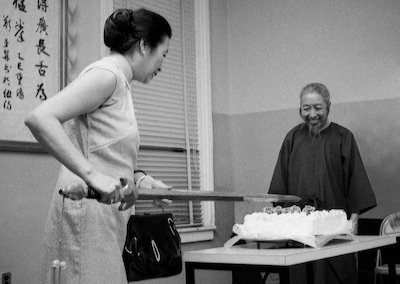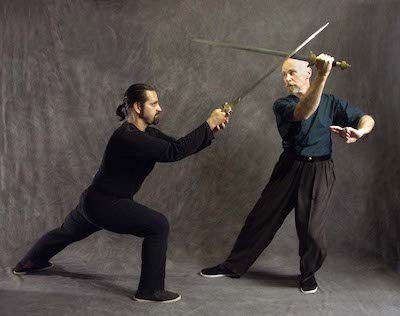Of course the body must keep the basic alignment that we developed while doing the form and push hands. One mistake that cannot be tolerated in fencing as much as it is in form and push hands is ‘butting’ which is leaning with the head forward.
The torso is mostly turned one eighth to the left, with your gaze facing the O. Your left sword fingers are positioned in front of your chest, as they are in “Raise Hands” in the solo form. Your gaze and your blade face the O. When the O advances toward you, circle to your left, this will get you out of the way as it brings your left hand in closer proximity to the O’s right arm. We do not back up more than one step, since we prefer not to back into a wall, off a cliff or into a friend of the O.
(In western sport fencing they play on a long narrow strip, and mostly move back and forth.)
The edge of the blade must move exactly in the direction of the blade’s movement. For example in a horizontal cut any upward tilt of the leading edge will cause it to ‘fly’, to move upward off its intended path. If there is a downward tilt, it will ‘dive’, moving downward off its intended path. If one of these off – line cuts were to meet flesh while using a sharp sword, a messy gash would result instead of a clean cut. If it met something hard like a bone or branch it would very likely twist, causing damage to the wielder’s wrist.

With all thrusts the blade should move in a straight line, like an arrow, without any wavering or wagging. The exception to this rule is in the three jumps wherein the sword makes a wave motion.
In cutting moves a good test of power alignment is to let someone hold the sword point then try to make the move from your centre. This exercise will allow you to feel the correct line – up of your body to shoulder, to elbow, to grip, to edge or to point.
Alignment doesn’t mean that things are always in a straight line, but that components must be aligned according to their nature and their function. Many of our Tai Chi alignments are circular or angular; they are combinations of body, direction, energy and purpose or intention.
Keep in mind that the final alignment we are all reaching for by practising these basic alignments is the alignment of our essential self with that of the TAO.
Author and Images: Ken van Sickle
German version on our sister site!
- ON BEING A MASTER – Tai Chi Sword 53
- STRANGERS – Tai Chi Sword 52
- PADDED SWORDS – Tai Chi Sword 51
- SAFETY – Tai Chi Sword 50
- PARALLELS – Tai Chi Sword 49
- Swordsmanship – SEVEN QUOTES – Tai Chi Sword 48
- TI FENG & FA JING – Tai Chi Sword 47
- SUPPOSITIONS – Tai Chi Sword 46
- LAO TZU (Laozi) QUOTES – Tai Chi Sword 45
- ETIQUETTE – Tai Chi Sword 44
- FENCING PROCESS – Tai Chi Sword 43
- STRATEGIES – Tai Chi Sword 42
- TASSELS IN THE WIND – Tai Chi Sword 41
- SHOOT FLYING GOOSE – Tai Chi Sword 40
- RHINOCEROS GAZES AT MOON – Tai Chi Sword 39
- THE MASTER SITS BACK – Tai Chi Sword 38
- FIVE APPLICATIONS – 1. BLOCK AND SWEEP – Tai Chi Sword 37
- RULES OF ENGAGEMENT – Tai Chi Sword 36
- CONSIDER – Tai Chi Sword 35
- INVITATIONS – Tai Chi Sword 34
- THE TASSEL – Tai Chi Sword 33
- THE SWORD FINGERS – Tai Chi Sword 32
- Cheng Man Ching Photographs
- THE JOINTS – Tai Chi Sword 31
- THE GRIP – Tai Chi Sword 30
- SWORD MOVEMENT – Tai Chi Sword 29
- ON ALIGNMENT – Tai Chi Sword 28
- CONCERNING THE CENTRE – Tai Chi Sword 27
- EQUATIONS – Tai Chi Sword 26
- HSIN AND CHI – Tai Chi Sword 25
- On studying – NINE QUOTES – Tai Chi Sword 24
- THE SWORD MAIDENS – Tai Chi Sword 23
- THE SWORD AND CALLIGRAPHY – Tai Chi Sword 22
- Returning – MORE THOUGHTS – Tai Chi Sword 21
- Levels of TAI CHI SWORD – Tai Chi Sword 20
- FENCING – Tai Chi Sword 19
- Transcendence – Tai Chi Sword 18
- TURNING TRICKS – Tai Chi Sword 17
- Names of CHENG MAN CH’ING’S TAI CHI SWORD – Tai Chi Sword 16
- FORCE – Tai Chi Sword 15
- DIFFERENCES – Tai Chi Sword 14
- BEGINNERS’ MISTAKES – Tai Chi Sword 13
- MIND SETS – Tai Chi Sword 12
- SENSITIVITY – Tai Chi Sword 11
- HARMONY – Tai Chi Sword 10
- TIME AND HUMOUR – Tai Chi Sword 9
- WHY AND HOW – Tai Chi Sword 8
- SWORD DIMENSIONS – Tai Chi Sword 7
- A ROYALTY OF ARMS – Tai Chi Sword 6
- KENNETH VAN SICKLE – Tai Chi Sword 4
- CHENG MAN CH’ING – Tai Chi Sword 5
- PREFACE – Tai Chi Sword 3
- Introductory Thoughts – Tai Chi Sword 2
- EDITOR’S PREFACE -Tai Chi Sword 1
- Tai Chi Sword by Kenneth van Sickle
- Taiji Forum Qigong Weeks
 Join us for a trip into the fascinating world of Qigong!
Join us for a trip into the fascinating world of Qigong! - Taiji Forum Teemill Shop – Announcement
 Our Taiji Forum Shirt Shop is on the way – and growing!
Our Taiji Forum Shirt Shop is on the way – and growing! - Review on the International Push Hands Meeting 2024
 I am so glad I did, and wish I had done it before
I am so glad I did, and wish I had done it before - TuiShou is not fighting. So what is it then?
 In our view, tuishou is an exercise method which develops the tai chi qualities for martial use.
In our view, tuishou is an exercise method which develops the tai chi qualities for martial use. - Basic peng-lü drill push hands workshop
 you’ll learn a basic drill to explore the two fundamental jins (“powers”)
you’ll learn a basic drill to explore the two fundamental jins (“powers”) - The spiritual force of Yi in Push Hands
 our energy follows our attention/focus. –
our energy follows our attention/focus. – - Pushhands Patterns
 Ronja (Jantje) Hinze
Ronja (Jantje) Hinze - Music For Taijiquan Practice & Demonstration
 Music in the soul can be heard in the universe.
Music in the soul can be heard in the universe. - Push Hands Meeting 2024 beginners’ program
 The teachers and themes are published and the registration of Push Hands Meeting 2024 is ready!
The teachers and themes are published and the registration of Push Hands Meeting 2024 is ready!














